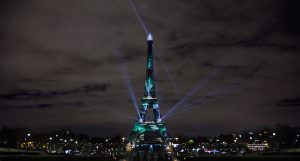Winners and Losers in Our New Media Moment
Remarkably often these days, the “news” is a single hyped-up story reported frenetically and yet formulaically, often in near-apocalyptic fashion. Mike Licht / CC BY 2.0
1
2
3
Mike Licht / CC BY 2.0
1
2
3
Sometimes what matters most takes up every inch of space in the room and somehow we still don’t see it. That’s how I feel about our present media moment.
Let me put it this way: I’m a creature of habit, and one of those habits has long been watching NBC Nightly News, previously with anchor Brian Williams and now with Lester Holt. It’s my way of getting some sense of what an aging cohort of American news viewers (like me) learns daily about the world — what stories are considered important and not, and in what order, and how presented.
Here’s one thing it’s hard not to notice: the line-up of stories that we used to call the “news” seems increasingly like a thing of the past. Remarkably often these days, the “news” is a single hyped-up story — most recently, the San Bernardino shootings — reported frenetically and yet formulaically, often in near-apocalyptic fashion. Clearly, such an approach is meant to glue eyeballs in a situation in which viewers are eternally restless and there are so many other screens available. This single story approach is both relentless and remarkably repetitious because a lot of the time next to nothing new is known about the supposedly unfolding event (which is nonetheless presented as if our lives depended upon it). To fall back on the anchor of Avon, it often enough seems like a tale told by a collective idiot, full of sound and fury, signifying nothing.
What this form of news certainly does is suck all the air out of the newsroom. On some days, when one of these 24/7 events is running wild, you could be excused, at the end of half an hour of “national news,” for thinking that nothing other than the event at screen center had happened anywhere on Earth. And I mean nothing. Not even the weather, generally such a favored subject of the nightly news because it offers disaster in its most picturesquely chaotic and yet expectable form.
Above all, the 24/7, all-hands-on-deck news story obliterates context, or rather becomes the only context of the moment. To offer the most obvious recent example: in the days in which the San Bernardino shootings ate the screen, most Americans would not have noticed that the fate of the planet was being seriously discussed and negotiated in Paris by representatives of just about every country. There was next to nothing but those shootings available — the exploration of the backgrounds of the two killers, their marriage, their arsenal of weaponry, a pledge of allegiance by the wife to ISIS, the contents of their house, what relatives and friends in Pakistan had to say, their bank account, heart-rending tales of those killed, testimony from survivors, and on and on. Even more than a week after the event, it was still the lead story on NBC Nightly News evening after evening. (“San Bernardino Shooters Discussed Jihad in 2013 Before Engagement,” “FBI Divers Search Lake Near San Bernardino Massacre for Clues.”) Viewers might be pardoned for thinking that Islamic terrorism was indeed an apocalyptic threat for most Americans rather than the distinctly minor one it is.
Sucking the Air Out of the Newsroom
Mass shootings, a particularly American phenomenon, seem like the perfect story for our news moment. They are guaranteed to eat any screen and recur so regularly, with uniquely gruesome twists, that covering them has become formulaic. They are the equivalent of no-brainers: disturbed (or disturbing) shooters, horrified victims, blood and guts, grim hospital scenes, the testimony of victims, the rites around the dead, and in the case of San Bernardino the added attraction (or repulsion) of Islamic terrorism.
Put another way, what passes for the news is often enough closer to a horror movie in which, just around the next corner, another nightmare is readying itself to leap out and scare you to death. Maybe it’s not what you really want to see, but once it starts, you can’t take your eyes off it. And that’s the point.
Unfortunately, none of this is actually a horror movie. When these all-too-real events loom so much larger than life and without context, they seem to trigger panic, fear, even hysteria, and a profound sense of endangerment in many Americans; they create, that is, a vision of how the world works and of its dangers that bears little relationship to the place we actually live.
Someday someone will surely figure out how to create a panic, fear, and hysteria, or PFH, index (in a world where nothing should be without its acronym) to measure the effects of this phenomenon. One way to gauge it in the meantime is via opinion polls. In the week after the San Bernardino coverage, for instance, the number of Americans who expressed satisfaction with the way things are going in this country took a “rare” seven percentage point nosedive, according to a Gallup poll. Similarly, a New York Times/CBS News poll found that, in the wake of those shootings, 19% of Americans now believed that “the threat of terrorism [is] the top issue facing the country.” Only 4% had a month earlier.
Your support matters…Independent journalism is under threat and overshadowed by heavily funded mainstream media.
You can help level the playing field. Become a member.
Your tax-deductible contribution keeps us digging beneath the headlines to give you thought-provoking, investigative reporting and analysis that unearths what's really happening- without compromise.
Give today to support our courageous, independent journalists.





You need to be a supporter to comment.
There are currently no responses to this article.
Be the first to respond.